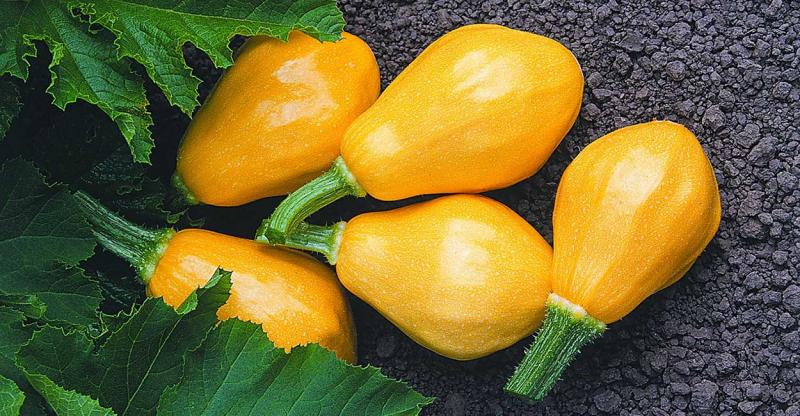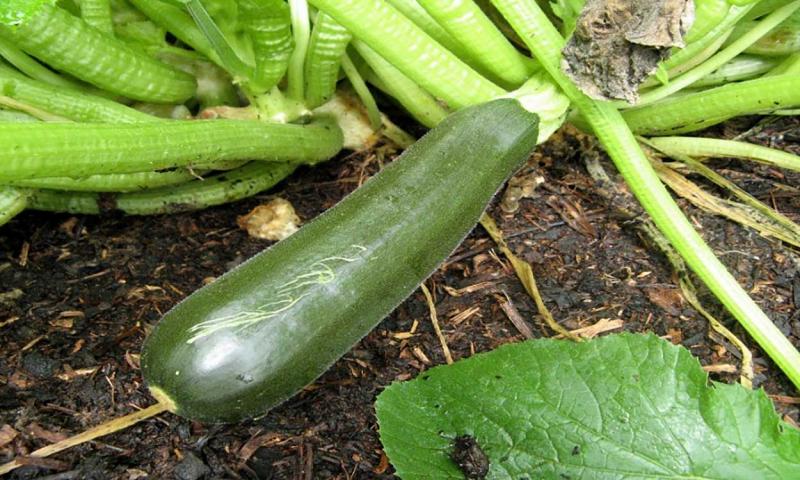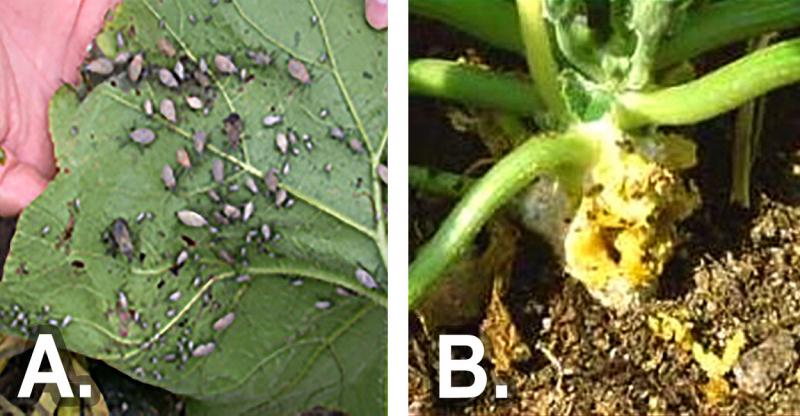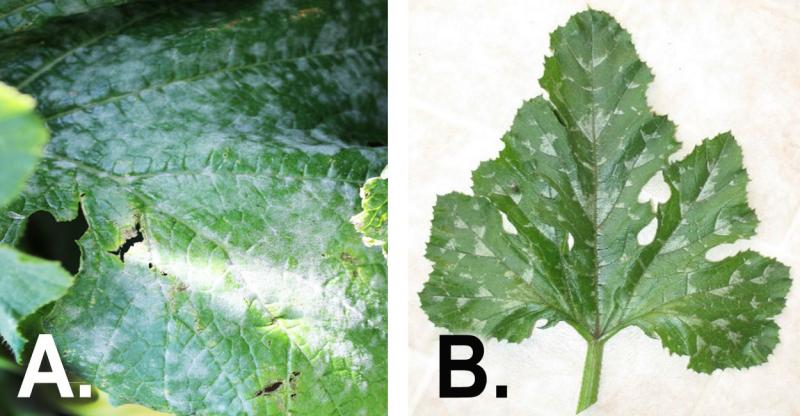Written by Rhoda Burrows, former Professor & SDSU Extension Horticulture Specialist.
Description

General Description: There are many types of summer squash, including the familiar zucchini (which can be green, green-striped, or yellow), crookneck, straightneck, patty pan and more.
Squash plants bear separate male and female flowers, and pollen must be transferred from the male flowers to the female flowers by insects, mostly bees. One can identify the female flowers by the miniature fruit at the base.
Squash flowers can also be harvested the day they begin to open and fried or stuffed; this is a good use of male flowers when they appear a few days before female flowers.
Planting

Timeline: Plant summer squash after the chance of frost has passed, or when soil temperatures reach 70° Fahrenheit (Figure 2). Visit the Mesonet at SDState’s Freeze/Frost Dates website for growing season information specific to your area.

Sowing and Transplanting: Direct seeding is the preferred method for starting squash, as the seed germinate quickly and easily, and roots will grow deeper than if transplants are used. If transplants are used, they should be young, having no more than 1 or 2 true leaves.
Sow seeds about ½ inch deep and about 2 inches apart. Allow 2 to 3 feet of space on either side of the row for the vines to spread. After seedlings emerge, thin to stand 8 to 12 inches apart.
A hill (soil piled 2 to 3 inches high) of 3 to 4 seeds sown close together is another way to plant squash, good especially in heavy clay soils. Allow 5 to 6 feet between hills.
Planting Note: A common misconception is that planting squash or cucumbers near gourds can cause abnormal fruit. Summer squash, gourds, and some types of pumpkins and winter squash can cross-pollinate each other. However, the result will only affect the seed and the resulting plant the following year; it will not affect the current season’s fruit. So, unless you plan on saving the seed, you can plant these vegetables next to each other without any ill effects. If you do save the seed from your own garden, note the warning below!
WARNING: Quite rarely, a genetic mutation or an accidental crossing with wild cucurbits or gourds, can occur that produces a plant that bears very bitter fruit. The bitter substance is cucurbitacin, and it is poisonous. It can cause nausea, stomach cramps and diarrhea, even in very small amounts (one bite). If you taste a squash and find it very bitter, spit it out, and discard any fruit from that plant (and the plant itself).
Plant Care
Watering: Vine crops need at least one inch of water from rainfall or irrigation each week during the growing season. Always soak the soil. Drip irrigation is preferred to reduce leaf diseases.
Mulching: Black plastic mulch is sometimes used to decrease weeds. Apply black mulch once the soil has been prepared in the spring. A clear plastic placed over the soil for a few days before planting can help warm the soil for good seed germination. Remove it before planting.
Weeding: Frequent, shallow cultivation will kill weeds before they become a problem.
Fertilizing: Apply well-rotted or composted manure in the fall or early in the spring before planting. Never use fresh manure, as it may contain pathogens that could contaminate your food. Sprinkling 1 to 2 Tablespoons of lawn fertilizer around the plant once the plant starts to flower can help it produce more fruit (Make certain it contains only fertilizer, and that it is not a weed and feed product containing herbicide). If the plant is already growing well with large, dark-green leaves, it likely does not need any additional fertilizer.
Pests and Diseases

Major Pests
- Squash Bugs: Squash bugs feed on foliage and can harm young plants (Figure 3-A). In high numbers, they can inject a toxin that kills the foliage.
- Squash Vine Borers: Squash Vine Borers can kill plants as they tunnel through vines (Figure 3-B). Sometimes a vine can be saved by slitting the plant enough to remove the larvae at soil level and keeping moist soil over the crown to encourage new roots to form.
- Striped Cucumber Beetles: Damage plants by eating leaves as well as stems and fruit. They are also a potential vector of bacterial wilt and squash mosaic virus.

Diseases
Powdery Mildew: Powdery mildew is a disease that’s common in hot weather. Leaves can become covered in a whitish mold (Figure 4-A). Many varieties of squash are resistant to the disease. Look for these when selecting seed.
Minor Problems
Blossom End Rot: The end of the fruit most distant to the plant turns brown. This may be an indication of a lack of calcium in the soil. The disease is most-often found when plants are grown in artificial media, such as containers. It can also occur due to uneven watering. See Blossom End Rot on Tomatoes and Other Vegetables for more information.
Harvest
Harvest: Days to harvest range from 50 to 75 days, depending on variety. Pick summer squash when they reach the size you prefer but before the seeds become tough. Generally, zucchini should be 6 to 10 inches-long. If very large squash fruits are left on the vine, plant yield will decline, so remove fruits that have grown too large, even if you will not use them. Harvest every other day, or as necessary. Do not pick fruit when the vines are wet, because of the danger of spreading diseases.
Average Yield: 60 fruit per a 10-foot row. Four healthy plants will supply a family of four.
Storage and Preparation
Storage: Store summer squash in a relatively cool and humid place, ideally with temperatures around 45°F. It will keep about four days in a refrigerator. After that it will be damaged by the cold temperature.
Cooking: Summer squash can be steamed, fried, sautéd, grilled or baked, or even sliced raw into a salad. It can also be frozen, canned, or pickled. For more ideas, see our Pick it! Try it! Like it! resource for squash.
Nutrition Facts: Fat Free, Cholesterol free, sodium free, high in vitamin C and vitamin A


